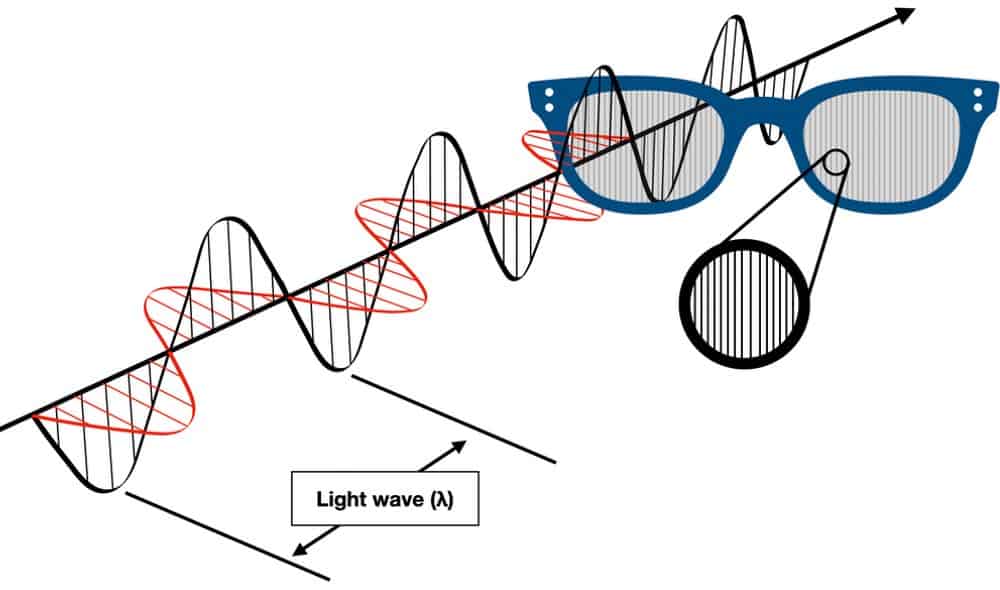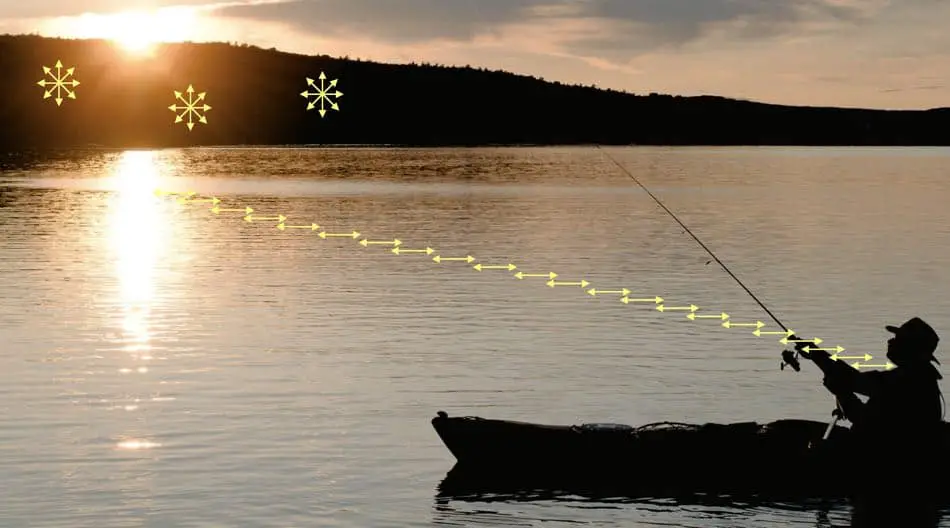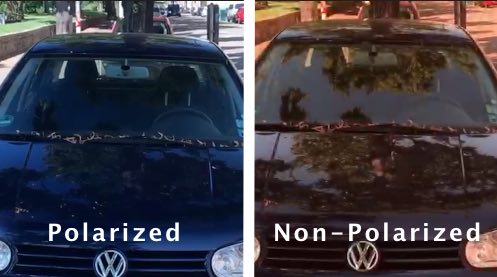Polarized sunglasses work by having a special molecular structure in the lenses. This way the light waves reflected by a surface at a certain angle get blocked out. In most cases the orientation of the polarized lenses is vertical.
With this orientation of the lenses, the light waves reflected by a horizontal surface like water, windshields, or the street will not glare at you anymore.

As you can see in the picture above the horizontal positioned light waves do not pass the lens while the vertical do. The polarization in sunglasses is highly dependent on the correct position of the sunglasses to the reflecting surface. This means if you tilt your head to the sides the glare will appear again.
In the picture above the light is oriented in just the vertical component and the horizontal. This is just shown in a simpler way for explanation purposes. The actual position of the light from the sun oscillates (is oriented) at every angle.

Here in the picture above you can exactly see how this works. The light from the sun oscillates in every direction. After the light of the sun got reflected by the surface of the water the light oscillates only in the horizontal orientation. When the polarized sunglasses are put in front of your eyes the light gets filtered again.
In this process the already polarized reflected light will be filtered out.
But How Does the Process Actually Work With Polarizing Sunglasses?
Usually, a special foil is placed in a sandwich technique between two lenses. In the part of this article above, we discussed what you can experience with polarized sunglasses and I mentioned the special molecular structure the foil needs to have in order to reduce the glare effectively.
The foil for polarized sunglasses is made out of plastic which gets stretched during the manufacturing process. The Strech causes the molecular structure to align in one particular direction.
One thing that I need to add here for an easier understanding is how electrons in the molecules of the sunglass filter behave. Electrons are set to oscillate by the incoming light wave and therefore some of the wave energy of the light gets transferred to the electrons to be dissipated or reflected by the electrons.
Polarized sunglasses contain molecules that make it is easy for the electrons to oscillate in the horizontal direction thus dissipating more horizontally polarized light energy. On the other hand, the long molecules make it hard for electrons to oscillate in the vertical direction.
Are Polarized Sunglasses Worth It?
Polarized sunglasses are absolutely worth it if they get used in the right environment. My customers especially enjoy polarized sunglasses when they use the sunglasses during the following activities.
- Fishing
- Driving your car
- Skiing or snowboarding
Basically, all those activities take place in an environment in which you are surrounded by horizontal surfaces that probably produce glare when the light is reflected by its surface.
With the reduction of glare on the road, in the snow, or on the water you will have better contrast and less visual stress due to the eliminated glare. I personally really like polarized sunglasses and recommend them often.
But there are some situations in which polarized sunglasses might not be the best choice. One of those situations is riding your motorcycle. If the glare gets eliminated by polarization puddles on the street will not be as visible compared to normal sunglasses.
Another downside of polarized sunglasses is when you want to use a head-up-display in your car. Due to its position in the car, it gets very dim or is not visible to you at all.
Personally, this does not bother me but if you use the head-up-display all the time this might be an issue for you. Depending on the mobile phone you use it might not work with polarized sunglasses. A lot of people need to use their phones in a special orientation so the sunglasses do not block the light emitted by the display.
Are They Available With a Gradient?
Polarized sunglasses also work with a gradient in the tint. This way the sky gets darker compared to the lower half of the sunglasses. A lot of people like this option because it reduces the bright light from the sky effectively while your dashboard in your car does not appear as dark as without the gradient.
The lower part of the gradient with polarized sunglasses can not be as transparent as with normal tinted sunglasses. One reason is therefore is the foil that leads to the polarization. It usually comes with a light tint or a tint of at least 50%.
Polarized Sunglasses vs Non-Polarized Sunglasses
The difference between polarized sunglasses vs non-polarized sunglasses can be seen in the picture below. Here you can see the effect of the polarization. On the left side, you can see a lot fewer reflections on the surface of the car. They are just minimized instead of totally eliminated due to the imperfect angle the light waves get reflected into the camera.

On the right side in the picture above you can see the effect of non-polarized sunglasses. They just make the picture darker but you could still be blinded while the polarized sunglasses directly minimize the glare.
Personally, I wore polarized sunglasses for 15 years and as an optician, I believe the advantages by far exceed the disadvantages of polarized sunglasses. Even cheaper polarized sunglasses will do the job by effectively minimizing the glare.
My recommendation is oftentimes Maui Jim sunglasses because of the popping colors they provide. The contrast is just superior to other sunglasses and a lot of people notice this too. Just visit your local optician and try different models out.
Conclusion
Polarized sunglasses work for most people and will give them more contrast and reduce the glare from horizontal surfaces effectively.
I wish you a great day.
